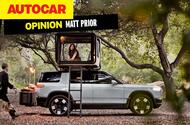Prior riffs on batteries, camping in an EV, and the man sending 24 ambulances to Ukraine
Recently, I drove the Dacia Spring, a small electric car with a 140-mile range when new (and warm and not on a motorway).
Also last week, my munchkins climbed into a 16-year-old small car and drove 140 miles to camp at a wet music festival. When they had to stop to refuel (once, on their way home), it took them only a few minutes.
Fast forward to 2040 and their equivalents might still be tooling around in a combustion-engined city car or supermini – or they could find themselves instead driving an old small electric car, more tired and less rangy than it is today.
Having such a weekend away will still be doable, of course, but it will take longer. One might stop to shop while charging on the way, maybe, rather than buying instant noodles and Jaffa Cakes the night before.
The impromptu freedoms we’ve taken for granted – throwing some kit into the car on a spare weekend and taking a spontaneous long trip to the Lakes or Devon or wherever – will be more daunting in an old Spring than they are now in an old Citroën C1. Maybe prohibitively so.
I genuinely think that by 2030, we will look back at today’s cutting edge and think it wasn’t good enough. Not a reason to give up eradicating tailpipe emissions but enough to wish solid-state batteries, which promise double the energy density and triple the charging speed, into the mainstream as soon as possible.
Because there’s lots to like about the idea of heading into the sticks in an EV. Mooching down a green lane with the windows and roof down, accompanied by only birdsong, the breeze and the scrunch of tyre upon dirt, is something that I’ve done in a plug-in hybrid Jeep Wrangler, and it’s really compelling.
Then when you get to where you’re going, you can set up shop and plug things into the car: lighting, devices, a kettle, a stove, a fridge, a tent heater on which to dry your socks.
In selling the electric dream, particularly with lifestyle-oriented cars, I wonder if manufacturers make quite enough of this. It doesn’t have to be the wilderness, it could be just a day out, but you can keep your sandwiches colder, your tea warmer and your feet drier.
Mighty Convoy and sending ambulances to Ukraine
My friend Simon Brake, who runs Mighty Convoy, a non-profit organisation that has so far raised £160,000 to take 24 ambulances to Ukraine across seven trips, has called to say that his Ukrainian charity contacts wonder if he’s able to bring 4x4s the next time Mighty Convoy drives to Lviv to donate vehicles, this October.
Winter isn’t far away, and extracting casualties from the front lines away from roads isn’t as practicable in van-based ambulances as it would be in four-wheel-drive pick-up trucks like the Ford Ranger and Toyota Hilux.
Mighty Convoy has great UK contacts to secure used ambulances, which get a proper once-over before making the trip across the continent so Brake is confident they’re in good condition.
But while he’s terrific at raising dosh and organising trips, he’s no expert on vehicles in general or 4x4s in particular, and in short, he doesn’t know where to source good 4x4s. He doesn’t think he knows enough to buy random ones at auction, so he’s hoping to find someone who retails them and gives them a good once-over first.
Donations enable Mighty Convoy to pay £6000 to £8000 per vehicle, and it pays such prices because not only do they have to reach Ukraine reliably, but they must withstand repeated hard use when they get there too.
If you are or know someone who can help, drop me a note and I will put you in touch, or visit mightyconvoy.org.

